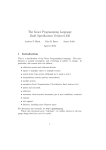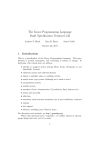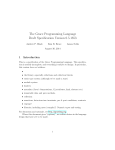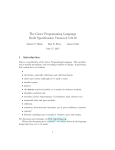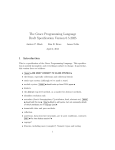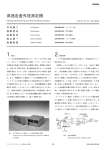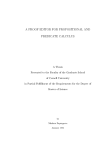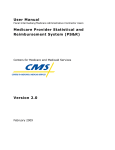Download The Grace Programming Language Draft Specification Version 0.353
Transcript
The Grace Programming Language
Draft Specification Version 0.353
Andrew P. Black
Kim B. Bruce
James Noble
April 3, 2012
1
Introduction
This is a specification of the Grace Programming Language. This specification is notably incomplete, and everything is subject to change. In
particular, this version does not address:
• collection syntax and collection literals
• tuples vs multiple values vs multiple returns
• nested static type system (although we’ve made a start)
• encapsulation system (privacy annotations)
• module system
• metadata (Java’s @annotations, C] attributes, final, abstract etc)
• purity and non-nulls.
• reflection
• assertions, data-structure invariants, pre & post conditions, contracts
• regexps
• test support
• libraries, including more Numeric types
For discussion and rationale, see http://gracelang.org.
Where this document gives “(options)”, we outline choices in the language design that have yet to be made.
1
2
2
Id: spec.tex 323 2012-04-02 21:53:22Z black
User Model
All designers in fact have user and use models consciously
or subconsciously in mind as they work. Team design. . . requires
explicit models and assumptions.
Frederick P. Brooks, The Design of Design. 2010.
1. First year university students learning programming in CS1 and CS2
classes that are based on object-oriented programming.
(a) The courses may be structured objects first, or imperative first.
Is it necessary to support “procedures first”?
(b) The courses may be taught using dynamic types, static types, or
both in combination (in either order).
(c) We aim to offer some (but not necessarily complete) support for
“functional first” curricula, primarily for courses that proceed
rapidly to imperative and object-oriented programming.
2. University students taking second year classes in programming; algorithms and data structures, concurrent programming, software craft,
and software design.
3. Faculty and teaching assistants developing libraries, frameworks, examples, problems and solutions, for first and second year programming
classes.
4. Programming language researchers needing a contemporary objectoriented programming language as a research vehicle.
5. Designers of other programming or scripting languages in search of a
good example of contemporary OO language design.
Id: spec.tex 323 2012-04-02 21:53:22Z black
3
3
Syntax
Much of the following text assumes the reader has a minimal
grasp of computer terminology and a “feeling” for the structure
of a program.
Kathleen Jensen and Niklaus Wirth, Pascal: User Manual and Report.
Grace programs are written in Unicode. Reserved words are written in the
ASCII subset of Unicode. As a matter of policy, the names of methods
defined in the required libraries are also restricted to the ASCII subset of
Unicode.
3.1
Layout
Grace uses curly brackets for grouping, and semicolons as statement terminators, and infers semicolons at the end of lines. Code layout cannot be
inconsistent with grouping.
code with punctuation:
while {stream.hasNext} do {
print (stream.read );
};
code without punctuation:
while {stream.hasNext} do {
print (stream.read)
}
A line break followed by an increase in the indent level implies a line
continuation, whereas line break followed by the next line at the same or
lesser indentation implies a semicolon (if one is permitted syntatically).
3.2
Comments
Grace’s comments delimiters follow C++ and Java’s line (“//”) comments.
Comments are not treated as white-space; each comment is conceptually
attached to the smallest immediately preceding syntactic unit; comments
following a blank line are attached to the largest immediately following
syntactic unit.
// comment to end−of−line
4
Id: spec.tex 323 2012-04-02 21:53:22Z black
3.3
Identifiers
Identifiers in Grace must begin with a letter and consist of letters and digits
thereafter.
Prime ’ characters may be used after the first character of an identifier.
An underscore “ ” acts as a placeholder identifier: it is treated as a fresh
identifier everywhere it is used.
3.4
Reserved Words and Operators
Grace has the following reserved words and reserved operators. The ? indicates words related to design options not yet chosen.
assert case catch class const def extends false finally method object
outer(?) prefix raise return self Selftype super true type var where
. : = = ; { } [ ] ” ( ) : −>
3.5
Tabs and Control Characters
Newline can be represented either by carriage return or by line feed; however,
a line feed that immediately follows a carriage return is ignored.
Tabs and all other non-printing control characters (except carriage and
line feed) are syntax errors, even in a string literal. (There are escape
sequences for including special characters in string literals.)
4
Built-in Objects
4.1
Numbers
Grace supports a single type Number. Number maintains rational computations in arbitrary precision, and inexact irrational computations approximated to at least 64bit precision.
Implementations may support other numeric types: a full specification
of numeric types is yet to be completed.
Grace has three syntactic forms for numerals (literals that denote Numbers):
1. decimal numerals, written as strings of digits, optionally preceded by
a minus;
Id: spec.tex 323 2012-04-02 21:53:22Z black
5
2. explicit radix numerals, written as a (decimal) number between 2 and
35 representing the radix, a leading x, and a string of digits, where the
digits from 10 to 35 are represented by the letters A to Z, in either
upper or lower case. As a special case, a radix of 0 is taken to mean a
radix of 16. Explicit radix numerals may not be preceded by a minus.
3. base-exponent numerals, always in decimal, which use e as the exponent indicator. Base-exponent numerals may be preceded by a minus.
All literals evaluate to exact rational Numbers; explicit conversions (such as
f64) must be used to convert rationals to other types.
Examples
1
−1
42
3.14159265
13.343e−12
−414.45e3
16xF00F00
2x10110100
0xdeadbeef // Radix zero treated as 16
4.2
Booleans
The keywords true and false denote the only two values of Grace’s Boolean
type. Boolean operators are written using && for and, || for or, and prefix
! for not.
Examples
P && Q
toBe || toBe.not
“Short circuit” (a.k.a non-commutative) boolean operators take blocks
as their second argument:
Examples
P andAlso { Q }
toBe orElse { ! toBe }
6
4.3
Id: spec.tex 323 2012-04-02 21:53:22Z black
Strings and Characters
String literals in Grace are written between double quotes. Strings literals
support a range of escape characters such as ”\t\b”, and also escapes for
Unicode; these are listed in Table 1 Individual characters are represented
by Strings of length 1. Strings are immutable Grace values (see §10) and so
may be interned. Strings conform to the protocol of an immutable IndexableCollection, and Grace’s standard library includes mechanisms to support
efficient incremental string construction.
Escape
\\
\"
\n
\t
\f
\{
\ (\ space)
Meaning
backslash
double quote
line-feed
tab
page down
left bracket
non-breaking space
Escape
\’
\b
\r
\l
\e
\}
Meaning
single quote
backspace
carriage-return
unicode newline
escape.
right bracket
Table 1: Grace string escapes.
Examples
”Hello World!”
”\t”
”The End of the Line\n”
”A”
4.4
String interpolation
Within a string literal, Grace treats expressions enclosed in braces specially.
The expression is evaluated, the asString method is requested on the resulting object, and the resulting string is inserted into the string literal in place
of the brace expression.
Examples
”Adding {a} to {b} gives {a+b}”
Id: spec.tex 323 2012-04-02 21:53:22Z black
5
7
Blocks
Grace blocks are lambda expressions; they may or may not have parameters.
If a parameter list is present, the parameters are separated by commas and
terminated by the −> symbol.
{do.something}
{ i −> i +1}
{ sum, next −> sum +next }
Blocks construct objects with a single method named apply, apply(n),
apply(n, m), . . . depending on the number of parameters. Requesting the
apply method evaluates the block. It is an error to provide the wrong number
of arguments.
for (1..10) do {
i −> print i
}
might be implemented as
method for ( collection ) do (block) {
...
block . apply( collection . at( i ))
...
}
Here is another example:
var sum := 0
def summingBlock : Block<Number,Number> =
{ i :Number −> sum := sum +i }
summingBlock.apply(4)
// sum is now 4
summingBlock.apply(32)
// sum in now 36
Blocks are lexically scoped inside their containing method or block. A
“naked” block literal that is neither the target of a method request nor
passed as an argument is a syntax error.
The body of a block consists of a sequence of declarations and expressions.
6
Declarations
Def and var declarations may occur anywhere within a method or block:
their scope is the whole of their defining block or method.
8
Id: spec.tex 323 2012-04-02 21:53:22Z black
It is an error to declare an identifier that shadows a lexically enclosing
identifier.
6.1
Constants
Constant definitions bind an identifier to the value of an initializer expression, optionally at a precise type.
Examples
def x = 3 ∗ 100 ∗ 0.01
def x:Number =3
// means the same as the above
def x:Number // Syntax Error : x must be initialised
Grace has a single namespace for methods and constants (and variables
and types and . . . ). A constant declaration of x can be seen as creating a
(nullary) reader method x.
6.2
Variables
Grace supports variable declarations using the var keyword.
Uninitialized variables (of any type) are given a special “ uninitialized ”
value; accessing this value is an error (caught either at run time or at compile
time, depending on the cleverness of your implementor).
Examples
var x : = 3
var x: Rational : = 3
// type of x is inferred .
// explicit type.
Instance variables are reassigned using assignment methods (see §8.2). A
variable declaration of “x” can be seen as creating a reader method “x” and
an assignment method “x: =(1)” Grace’s encapsulation system will control
the accessibility of each of these methods. You can think of the real instance
variable as having a unique secret name, which is known only to the accessor
methods.
Block and method temporary variables really exist, and can be the targets of real assignment statements.
It’s a deliberate design decision that assignment to a local variable and
requesting an assignment method on an object look identical.
It is an error to declare a block or method temporary variable that
shadows an enclosing method or assignment method (see §6)
Id: spec.tex 323 2012-04-02 21:53:22Z black
9
Assignments return Nothing (Void/None/etc).
6.3
Methods
Methods are declared with the method keyword, a name, optionally an
argument list, potentially repeated, optionally a return type declaration,
and a method body. Methods may not be nested.
Methods may contain one or more return e statements. If a return statement is executed, the method terminates with the value of the expression e.
If the method returns None, then no expression may follow the return. If execution reaches the end of the method body without executing a return, the
method terminates and returns the value of the last expression evaluated.
Assignment methods are named by an identifier suffixed with “: =”.
Prefix operator methods are named “prefix” followed by the operator
character(s).
Methods may have “repeated parameters” to allow them to take a variable number of parameters, that is to provide what is often called “variable
arity” or “varargs”. A repeated parameters, if present, must be the last
parameter in a part of a multipart method name. Repeated parameters
are designated by a star “∗” before the name of the parameter. Inside the
method, a repeated parameter has the type of an immutable collection of
the declared type — for example, a parameter declared ∗args : String has
the type args : ImmutableCollection<String>
Methods may be declared with generic type parameters, in whcih case
they must be requested with generic type arguments. Gneric type parameters may be constrained with where clauses.
Examples
method pi {3.141592634}
method greetUser {print ‘‘ Hello World!’’}
method +(other : Point) −> Point { (x +other.x) @ (y +other .y) }
method +(other)
{ (x +other .x) @ (y +other .y) }
method +(other)
{ return (x +other .x) @ (y +other .y) }
10
Id: spec.tex 323 2012-04-02 21:53:22Z black
method foo:=(n : Number) −> None {
print ”Foo currently {foo}, now assigned {n}”
super.foo: = n }
method choseBetween (a : Block<None>) and (b : Block<None>) −> None {
if (Random.nextBoolean)
then {a.apply} else {b.apply} }
method print( ∗args : Printable ) −> None
method sumSq<T>(a : T, b : T) −> T where T <: Numeric
{(a ∗ a) + (b ∗ b)}
class NumberFactory {
method prefix− −> Number
{ 0 − self }
}
7
Objects and Classes
Grace object constructor expressions and declarations produce individual
objects. Grace provides class declarations to create classes of objects all of
which have the same structure.
Grace’s class and inheritance design is complete but tentative. We need
experience before confirming the design.
7.1
Objects
Objects are created by object literals. The body of an object literal consists
of a sequence of declarations.
object {
def colour :Colour = Colour.tabby
def name:String = ”Unnamed”
var miceEaten := 0
}
Object literals are lexically scoped inside their containing method, or
block. In particular, any object-level expressions, initializer expressions and
method bodies are executed in that lexical context. Each time an object
literal is executed, a new object is created.
Id: spec.tex 323 2012-04-02 21:53:22Z black
11
A constant can be defined by an object literal, such as:
def unnamedCat = object {
def colour : Colour = Colour.tabby
def name : String = ”Unnamed”
var miceEaten := 0 }
to bind a name to an object. Repeated invocations of the reader method
unnamedCat return the same object.
7.2
Classes
Objects literals have no provision for initializing the constant and variable
attributes of the created object other than via lexical scope.
Class declarations combine the definition of an object with the definition
of a factory object, where the factory object has a method that creates
“instances of the class”. A class declaration is syntactically similar to the
method declaration for the factory method, where the body of the factory
method is the body of an object literal:
Examples
class aCat.ofColour ( aColour ) named (aName) {
def colour : Colour = aColour
def name : String = aName
var miceEaten := 0
}
The ofColour()named() method takes two arguments; the object that it
returns has the fields and methods listed in the body of the constructor that follows the name of the factory method. So, in the above example, the constants colour and name are initialized from the parameters
aColour and aName, which are in turn initialized from the arguments to
. ofColour()named():
def fergus = aCat.ofColour ” tortoiseshell ” named ”Fergus Trouble”
If the programmer wants a factory object with more than one method,
she is free to build such an object using nested object constructors. The
above declaration for class aCat is equivalent (modulo types and modules)
to the following nested object declarations:
def aCat = object { // the cat factory
12
Id: spec.tex 323 2012-04-02 21:53:22Z black
method ofColour (aColour: Colour) named (aName: String) −> Cat {
object { // the cat herself
def colour : Colour : = aColour
def name : String : = aName
var miceEaten := 0
}
}
}
Notice that the type Cat describes the object returned from aCat.ofColour()named(),
not the factory object aCat.
7.3
Inheritance
Grace class declarations supports inheritance with “single subclassing, multiple subtyping” (like Java), by way of an inherits C clause in a class declaration or object literal.
A new declaration of a method can override an existing declaration, but
overriding declarations must be annotated with <override>. Overridden
methods can be accessed via super calls §8.6. It is a static error for a field
to override another field or a method. This example shows how a subclass
can override accessor methods for a variable defined in a superclass (in this
case, to always return 0 and to ignore assignments).
class aPedigreeCat.ofColour (aColour) named (aName) {
inherits Cat.ofColour (aColour) named (aName)
var prizes : = 0
<override> method miceEaten {0};
<override> method miceEaten:= (n:Number) {return} //ignore attempts to change it
}
The right hand side of an inherits clause is restricted to be a class name,
followed by a correct request for that class’s method.
7.4
Understanding Inheritance (under discussion)
Grace’s class declarations can be understood in terms of a flattening translation to object constructor expressions that build the factory object. Understanding this translation lets expert programmers build more flexible
factories.
The above declaration for class aPedigreeCat is broadly equivalent to
the following nested object declarations, not considering types, modules,
Id: spec.tex 323 2012-04-02 21:53:22Z black
13
and renaming superclass methods so that an object’s method names must
actually be unique.
def aPedigreeCat = object { // the cat factory
method ofColour (aColour: Colour) named (aName: String) −> PedigreeCat {
object { // the cat herself
def colour : Colour : = aColour
def name : String : = aName
<<private>> var Cat miceEaten := 0 // ugly . super−ugly
var prizes = 0
method miceEaten =0;
method miceEaten:=(n:Number) {return} //ignore attempts to change it
} // object
} // method
} // object
7.5
Generic Classes
Classes may optionally be declared with generic type parameters. The corresponding requests on the factory methods must be provided with type
arguments. Generic type parametrs may be constriained with where clauses.
Examples
class aVector. ofSize ( size )<T> {
var contents : = Array. size ( size )
method at(index : Number) −> T {return contents.at() }
method at(index : Number) put(elem : T) { }
}
class aSortedVector. ofSize <T>
where T <: Comparable<T> {
...
}
8
Method Requests
Grace is a pure object-oriented language. Everything in the language is an
object, and all computation proceeds by “requesting” an object to execute
a method with a particular name. The response of the object is to execute
the method. When speaking of Grace, we distinguish the act of requesting
14
Id: spec.tex 323 2012-04-02 21:53:22Z black
a method (which is exactly what Smalltalkers call “sending a message”),
and involves only a method name and some arguments, and executing that
method, which involves the code of the method, which is always local to the
receiver of the request.
8.1
Named Methods
A named method request is a receiver followed by a dot “.”, then a method
name (an identifier), then any arguments in parentheses. Parentheses are
not used if there are no arguments. To improve readability, a long argument
list may be interpolated between the “words” that makes up the method
name. This is determined by the declaration of the method. If the receiver
is self it may be left implicit, i.e., the self and the dot may both be omitted.
canvas.drawLineFrom(source)to(destination )
canvas.movePenToXY(x,y)
canvas.movePenToPoint(p)
print (”Hello world”)
pt.x
Grace does not allow overloading of method names.
Parenthesis may be omitted where they would enclose a single argument,
provided that argument is a literal other than an object literal.
8.2
Assignment Methods
A assignment method request is an explicit receiver followed by a dot, then
an identifier, followed by “:=”, and then a single argument.
Examples
x := 3
y: =2
widget. active : = true
Assignment methods return Nothing.
8.3
Binary Operator Methods
Grace allows operator symbols (sequences of operator characters) for binary
methods — methods with an explicit receiver and one argument. A binary
Id: spec.tex 323 2012-04-02 21:53:22Z black
15
operator method is one or more operator characters, and may not match a
reserved symbol (for example “.” is reserved, but “ .. ” is not).
Most Grace operators have the same precedence: it is a syntax error for
two different operator symbols to appear in an expression without parenthesis to indicate order of evaluation. The same operator symbol can be sent
more than once without parenthesis and is evaluated left-to-right.
Four simple arithmetic operators do have precedence: / and ∗ over + and
−.
Examples
1 + 2 + 3 // evaluates to 6
1 + (2 ∗ 3) // evaluates to 7
(1 + 2) ∗ 3 // evaluates to 9
1 + 2 ∗ 3 // evalutes to 7
1 +∗+ 4 −∗− 4 //syntax error
Named method requests without arguments bind more tightly than operator method requests. The following examples show first the Grace expressions as they would be written, followed by the parse.
Examples
1 + 2. i
(a ∗ a) + (b ∗ b). sqrt
((a ∗ a) + (b ∗ b )). sqrt
a ∗ a+b ∗ b
a+ b+ c
a −b−c
8.4
1 + (2. i )
(a ∗ a) + ((b ∗b). sqrt )
((a ∗ a) + (b ∗b)). sqrt
(a ∗ a) + (b ∗b)
(a + b) + c
(a − b) − c
Unary Prefix Operator Method
Grace supports unary prefix operator methods: since Grace does not support binary operator methods with implicit receivers there is no syntactic
ambiguity.
Prefix operators bind with the same precedence as method requests with
no arguments, and therefore need parenthesis to disambiguate.
16
Id: spec.tex 323 2012-04-02 21:53:22Z black
Examples
− (b + (4 ∗ a ). sqrt )
− b.squared
(−b).squared
−(b.squared)
status .ok : =
8.5
// illegal
!( engine . isOnFire) && wings.areAttached && isOnCourse
Accessing Operator Method
Grace supports an operator [] which can be defined in libraries, e.g., for
indexing collections.
Examples
print ( a [3] )
// requests method [] on a with argument 3
(option) Grace supports a two-argument accessing operator []: =.
Examples
a [3] : = ”Hello”
// requests method []:= on a with arguments 3 and ”Hello”
Note: Somewhere we need to have a list of reserved operators that cannot
be used normally.
8.6
Super Requests
The reserved word super may be used only as an explicit receiver. In overriding methods, method requests with the pseudo-receiver super request
the prior overridden method with the given name from self . Note that no
“search” is involved; super-requests can be resolved statically, unlike other
method requests.
Examples
super.foo
super.bar (1,2,6)
super.doThis(3) timesTo(”foo”)
super + 1
!super
foo(super) // syntax error
1 + super // syntax error
Id: spec.tex 323 2012-04-02 21:53:22Z black
8.7
17
Encapsulation
The design of Grace’s encapsulation system has not yet begun in earnest.
Grace will use metadata annotations to allow the declaration of confidential methods, that is, methods that can be requested only from self or
super.
8.8
Generic Method Requests
Methods may optionally be requested with actual generic type arguments
given explicitly. Where a method declared with formal generic type parameters is requested in a statically typed context without explicit actual generic
type arguments, the actual types arguments are inferred.
Examples
sumSq<Integer64>(10.i64, 20.i64)
sumSq(10.i64, 20.i64)
9
Control Flow
Control flow statements in Grace are syntactically method requests. While
the design of the module system is not complete (in fact, hardly yet begun)
we expect that instructors will need to define domain-specific control flow
constructs in libraries — and these constructs should look the same as the
rest of Grace.
9.1
Basic Control Flow
If statements:
if ( test ) then {block}
if ( test ) then {block} else {block}
While statement:
while { test } do {block}
For statement:
18
Id: spec.tex 323 2012-04-02 21:53:22Z black
for ( collection ) do {item −> block body}
for (course . students) do { s :Student −> print s }
for (0.. n) do { i −> print i }
To allow for conventional syntax with a leading keyword ( if , while, for ),
these methods are treated as if they were implicitly sent to self , which
implies that all objects must inherit the corresponding method.
9.2
Case
Grace supports a match/case construct. Match takes one argument and
matches it against a series of blocks introduced by “case”. Pattern matching
supports destructuring.
Examples
match (x)
// match against a literal constant
case { 0 −> ”Zero” }
// typematch, binding a variable − looks like a block with parameter
case { s : String −> print(s) }
// match against the value in an existing variable − requiring parenthesis like Scala
case { ( pi ) −> print(”Pi = ” ++ pi ) }
// destructuring match, binding variables ...
case { : Some(v) −> print(v) }
// match against placeholder , matches anything
case { −> print(”did not match”) }
9.2.1
API Design – Scary Overkill Monadic Version (under discussion)
Pattern matching is based around the Pattern type:
type Pattern<R,X> ={
Id: spec.tex 323 2012-04-02 21:53:22Z black
19
match(o : Any) −> MatchResult<R,X>
} where X <: Tuple
type MatchResult<R,X> ={
succeeded −> Boolean
next −> N
result −> R
bindings −> X
} where X <: Tuple
A pattern can test if any object matches the pattern, returing a MatchResult
which is either a SuccessfulMatch or a FailedMatch. From a successful match,
the result is the return value, typically the object matched, and the bindings
are a tuple of objects that may be bound to intermediate variables, generally used for destructuring objects. If a prefix of the object is matched, any
unmatched objects are returned in next.
A type declaration creates a singleton object that acts as a pattern. If
the type has an extract method that returns a tuple, X is the return type
of that method; if not, X is None.
For example, this Point type:
type Point = {
x −> Number
y −> Number
extract −> Tuple<Number,Number>
}
implemented by this CartesianPoint class:
class
def
def
def
}
CartesianPoint .new(x’ : Number, y’ : Number) −> Point {
x = x’
y = y’
extract = [x,y]
then these hold:
def cp : = CartesianPoint .new(10,20)
Point.match(cp).bindings // returns [10. 20]
Point.match(true)
// returns MatchFailure
20
Id: spec.tex 323 2012-04-02 21:53:22Z black
9.2.2
Translating Matching-blocks
Matching-blocks are blocks with one formal parameter. This parameter may
be a pattern, rather than just being a fresh variable (potentially with a type).
Matching-blocks are themselves patterns: one-argument (matching) block
with parameter type A and return type R also implements Pattern<R,None>.
A recursive, syntax-directed translation maps matching-blocks into blocks
with separate explict patterns non-matching blocks that are called via apply
only when their patterns match.
First, the matching block is flattened — translated into a straightforward
non-matching block with one parameter for every bound name or placeholder. For example:
{
: Pair(a, Pair(b,c)) −> ”{a} {b} {c}” }
is flattened into
{ , a, b, c −> ”{a} {b} {c}” }
then the pattern itself is translated into a composite object structure:
def mypat =
MatchAndDestructuringPattern.new(Pair,
VariablePattern .new(”a”),
MatchAndDestructuringPattern.new(Pair,
VariablePattern .new(”b”), VariablePattern .new(”c”)))
Finally, the translated pattern and block are glued together via a LambdaPattern:
LambdaPattern.new( mypat, { , a, b, c −> ”{a} {b} {c}” } )
The translation is as follows:
e
: e
v (fresh, unbound variable)
v (bound variable)
v : e
e( f ,g)
literal
e not otherwise translated
[[ e ]]
[[ e ]]
WildcardPattern
VariablePattern (”v”)
error
AndPattern.new(VariablePattern.new(”v”),[[ e ]] )
MatchAndDestructuringPattern.new(e, [[f]], [[g]])
literal
e
Id: spec.tex 323 2012-04-02 21:53:22Z black
9.2.3
21
Implementing Match-case
Finally the match(1)*case(N) methods can be implemented directly, e.g.:
method match(o : Any)
case(b1 : Block<B1,R>)
case(b2 : Block<B2,R>)
{
for [b1, b2] do { b −>
def rv = b.match(o)
if (rv .succeeded) then {return rv . result }
}
FailedMatchException.raise
}
or (because matching-blocks are patterns) in terms of pattern combinators:
method match(o : Any)
case(b1 : Block<B1,R>)
case(b2 : Block<B2,R>)
{
def rv = (b1 || b2).match(o)
if (rv .succeeded) then {return rv . result }
FailedMatchException.raise
}
First Class Patterns While all types are patterns, not all patterns are
types. For example, it would seems sensible for regular expressions to be
patterns, potentially created via one (or more) shorthand syntaxes (shorthands all defined in standard Grace)
match (myString)
case { ”” −> print ”null string ” }
case { Regexp.new(”[a−z]∗”) −> print ”lower case” }
case { ”[A−Z]∗”.r −> print ”UPPER CASE” }
case { /”[0−9]∗” −> print ”numeric” }
case { (”Forename:([A−Za−z]∗)Surname:([A−Za−z]∗)”.r2)(fn,sn) −>
print ”Passenger {fn . first } {sn}”}
With potentially justifiable special cases, more literals, e.g. things like
tuples/lists could be descructured [a,b ,...] −>a ∗ b. Although it would
22
Id: spec.tex 323 2012-04-02 21:53:22Z black
be very nice, it’s hard to see how e.g. points created with ”3@4” could
be destructed like a@b −>print ”x: {a}, y: {b}” without yet more bloated
special-case syntax.
Discussion This rules try to avoid literal conversions and ambiguous syntax. The potential ambiguity is whether to treat something as a variable declaration, and when as a first-class pattern. These rules (should!)
treat only fresh variables as intended binding instances, so a “pattern”
that syntactically matches a simple variable declaration (as in this block
{ empty −>print ”the singleton empty collection ” }) will raise an error —
even though this is unambiguous given Grace’s no shadowing rule.
Match statements that do nothing but match on types must distinguish
syntactically from a variable declaration, e.g.:
match (rv)
case { (FailedMatch) −> print ” failed ” }
case { : SuccessfulMatch −> print ”succeeded” }
while writing just:
match (rv)
case { FailedMatch −> print ” failed ” }
case { SuccessfulMatch −> print ”succeeded” }
although closer to the type declaration, less gratuitous, and perhaps less
error-prone, would result in two errors about variable shadowing.
Self-Matching For this to work, the main value types in Grace, the main
literals — Strings, Numbers — must be patterns that match themselves.
That’s what lets things like this work:
method fib(n : Number) {
match (n)
case { 0 −> 0 }
case { 1 −> 1 }
case { −> fib(n−1) +fib (n−2) }
}
With this design, there is a potential ambiguity regarding Booleans:
“true || false ” as an expression is very different from “true | false ” as a
composite pattern! Unfortunately, if Booleans are Patterns, then there’s no
way the type checker can distinguish these two cases.
Id: spec.tex 323 2012-04-02 21:53:22Z black
23
If you want to match against objects that are not patterns, you can
lift any object to a pattern that matches just that object by writing e.g.
LiteralPattern .new(o) (option — or something shorter, like a prefix =˜?).
(Option) matches could also be written as an operator e.g. p =˜ q for
p.match(q).succeeded. This might be good for scripts, but really it’s probably a very bad idea in general: that way lies Thorn.
9.3
Exceptions (under discussion)
Grace supports basic unchecked exceptions. Exceptions are generated by
requesting the raise method from an Exception class:
UserException. raise (”Oops ...! ”)
Exceptions are caught by a catch(1)case(1)” construct that syntactically
parallels match(1)case(1)”.
catch {def f = File .open(”data.store”)}
case {e : NoSuchFile −> print(”No Such File”); return}
case {e : PermissionError −> print(”No Such File”); return}
case {Exception −> print(”Unidentified Error ); System.exit}
finally {f . close }
Exceptions can’t be restarted. However, the stack frames that are terminated when an exception is raised should be pickled so that they can be used
in the error reporting machinery (debugger, stack trace). “catch(1)case(1) finally (1)”
construct and a “do(1) finally (1)” construct support finalization even through
exceptions. Following Scala, a “using(1)do(1)” construct supports resource
allocation and deallocation:
using ( Closable .new) do { stranger −> //bound to the new Closable
stranger .doSomething
}
// the close method is automatically requested of the
// Closable when the block terminates
10
Equality and Value Objects
All objects automatically implement the following non-overridable methods.
(option) Library programmers are able to override these methods.
24
Id: spec.tex 323 2012-04-02 21:53:22Z black
1. = = and ! = operators implemented as per Henry Baker’s “egal” predicate [2]. That is, immutable objects are egal if they are of the same
“shape”, have the same methods declared in the same lexical enviornments, and if their fields’ contents are egal, while mutable objects are
only ever egal to themselves.
2. hashcode compatible with the egal.
As a consequence, immutable objects (objects with no var fields, which
capture only other immutable objects) act as pure “value objects” without
identity. This means that a Grace implementation can support value objects
using whatever implementation is most efficient: either passing by reference
always, by passing some times by value, or even by inlining fields into their
containing objects, and updating the field if the containing object assigns a
new value.
11
Types
Grace uses structural typing [11, 34, 17]. Types primarily describe the requests objects can answer. Fields do not directly influence types, except in
so far as a field with publicly-visible accessor methods cause those methods
to be part of the type (and in general to be visible to unconstrained clients).
Unlike in other parts of Grace, Type declarations are always statically
typed, and their semantics may depend on the static types. The main case
for this is determining between identifiers that refer to types, and those that
refer to constant name definitions (introduced by def) which are interpreted
as Singleton types.
11.1
Basic Types
Grace’s standard prelude defines the following basic types:
• Object — the common interface of most objects
• Boolean — methods for true and false
• Number — numbers
• String — strings, and individual characters
• Pattern — pattern used in match/case statements
Id: spec.tex 323 2012-04-02 21:53:22Z black
25
• Dynamic — dynamically typed expressions. If no types are provided on
method formal parameters, the types are taken as dynamic by default.
There is also a top type, which can be written {} as an empty object
type.
11.2
Object Types
Object types give the type of objects’ methods. The various Cat object and
class descriptions (see §7) would produce objects that conform to an object
type such as the following.
{
colour −> Colour
name −> String
miceEaten −> Number
miceEaten:= ( : Number) −> None
}
For commonality with method declarations, method arguments may be
given both names and types within type declarations. A single identifier is
interpreted as a formal parameter name with type Dynamic.
11.3
Type Declarations
Types — and generic types — may be named in type declarations:
type MyCatType ={ color −> Colour; name −> String }
// I care only about names and colours
type MyGenericType<A,B> =
where A <: Hashable, where B <: disposable
{
hashStore( :A, :B) −> Boolean // pity not just (A,B)
cleanup( :B)
}
Grace has a single namespace: types live in the same namespace as
methods and variables.
11.4
Relationships between Types — Conformance Rules
The key relation between types is conformance. We write B <: A to mean
B conforms to A; that is, that B is a subtype of A, A is a supertype of B.
26
Id: spec.tex 323 2012-04-02 21:53:22Z black
This section draws heavily on the wording of the Modula-3 report [11], with
apologies to Luca Cardelli et al.
If B <: A, then every object of type B is also an object of type A. The
converse does not apply.
If A and B are ground object types, then B <: A iff
• B contains every method in A
• Every B method must have the same number of arguments as A, with
the same distribution in multi-part method names.
• Every method with parameters “(P1 , ...Pn ) −> R” in A must have a
corresponding method in B “(Q1 , ...Qn ) −> S”.
– Argument types may be contravariant: Pi <: Qi
– Results types may be covariant: S <: R
If a class or object B inherits from another class A, then B’s type should
conform to A’s type. If A and B are generic classes, then similar instantions
of their types should conform.
The conformance relationship is used in where clauses to constrain formal generic type parameters of classes and methods.
11.5
Any and None
The type Any is the supertype of all types — and may also be written as {}.
The type None is the subtype of all types. There are no instances of
None. In particular, neither undefined and nor any kind of nil is an instance
of None.
What happens if a method requested via Dynamic returns None, but the
caller attempts to use that None value?
11.6
Variant Types
Variables with untagged, retained variant types, written T1 | T2 ... | Tn ,
may refer to an object of any one of their component types. No objects
actually have variant types, only variables. The actual type of an object
referred to by a variant variable can be determined using that object’s reified
type information.
The only methods that may be requested via a variant type are methods
with exactly the same declaration across all members of the variant. (Option) methods with different signatures may be requested at the most most
specific argument types and least specific return type.
Id: spec.tex 323 2012-04-02 21:53:22Z black
27
Variant types are retained as variants: they are not equivalent to the object type which describes all common methods. This is so that the exhaustiveness of match/case statements can be determined statically. In detail:
S <: S | T;
T <: S | T
(S’ <: S) & (T’ <: T) =⇒ (S’ | T’) <: (S | T)
11.7
Intersection Types
(option) An object conforms to an Intersection type, written T1 & T2 & ... & Tn,
if and only if that object conforms to all of the component types. The main
use of intersection types is as bounds on where clauses.
class Happy<T>
where T <: (Comparable<T> & Printable & Happyable)
{
p −>
...
}
11.8
Union Types
(option) Structural union types (sums), written T1 + T2 + ... + Tn, may
refer to an object that conforms to any of the component types. Unions are
mostly included for completeness: variant types subsume most uses.
11.9
Type subtraction
(option) A type written T1 − T2 has the interface of T1 without any of the
methods in T2.
11.10
Singleton Types
The names of singleton objects, typically declared in object declarations,
may be used as types. Singleton types match only their singleton object.
Singleton typs can be distinguised from regular types because Grace type
declarations are statically typed.
def null = object { method isNull −> Boolean {return true} }
class Some<T> { thing : T −>
method isNull −> Boolean {return false} }
28
Id: spec.tex 323 2012-04-02 21:53:22Z black
type Option<T> =Some<T> | null
11.11
Nested Types
(Option) Types may be nested inside types, written T1.T2
In this way a type may be used as a specification module.
11.12
Additional Types of Types
(Option) Grace may support nullable types (written ?Type, defined as (Type| null ))
and exact types (written =Type)
(option) Grace probably will support Tuple types, probably written
Tuple<T1, T2... Tn>. We’re not yet sure how.
(Option) Grace may support selftypes, written Selftype.
11.13
Syntax for Types
This is very basic - but hopefully better than nothing!
Type := GroundType | (GroundType (”|” | ”&”) GroundType)...
GroundType ::= BasicType | BasicType ”<” Type ”,”... ”>” | ” Selftype ”
BasicType :: = TypeID | ”=” TypeID | ”?” TypeID | ”?=” TypeID
11.14
Reified Type Information Metaobjects and Type Literals
(option) Types are represented by objects of type Type (Hmm, should be
Type<T>?). Since Grace has a single namespace, so types can be accessed
by requesting their names.
To support anonymous type literals, types may be written in expressions:
type Type. This expression returns the type metaobject representing the
literal type.
11.15
Type Assertions
(option) Type assertions can be used to check conformance and equality of
types.
assert {B <: A}
// B ’conforms to’ A.
// B is a subtype of A
assert {B <: {foo( :C) −> D}
Id: spec.tex 323 2012-04-02 21:53:22Z black
29
// B had better have a foo method from C returning D
11.16
Notes
1. (Option) Classes define a type (of the same name) — currently this
is NOT part of Grace
2. (Sanity Check) these rules
3. (To be done) add in path types, types in objects.
4. What’s the relationship between “type members” across inheritance
(and subtyping???)
5. Classes are not types — are we sure about this?
6. Types are patterns (need to be to be matched against!)
7. Reified Generics formals are also patterns (see above)
8. On matching, How does destructuring match works? What’s the protocol? Who defines the extractor method? (not sure why this is here)
9. Somehow, do classes need to define a type that describes the objects
that are created by their factory methods.
10. Note that Generic Types use angle brackets, viz. ImmutableCollection<Figure>
11. can a type extend another type?
12. where do where clauses go?
13. method return types
14. Structural typing means we neither need nor want any variance annotations! Becaue Grace is structural, programmers can always write an
(anonymous) structural type that gives just the interface they need —
or such types could be storted in a library.
15. Should ObjectTypes permit formal parameter names or not? §11.2?
16. What actually gets returned from None? §6.3 §11.5
17. Tuples §11.12. Syntax as a type? Literal Tuple Syntax?
18. Nesting.
19. Serialization
30
12
Id: spec.tex 323 2012-04-02 21:53:22Z black
Pragmatics
The distribution medium for Grace programs, objects, and libraries is Grace
source code.
Grace source files should have the file extension . grace. If, for any bizzare
reason a trigraph extension is required, it should be . grc
Grace files may start with one or more lines beginning with “#”: these
lines are ignored.
12.1
Garbage Collection
Grace implementations should be garbage collected. Safepoints where GC
may occour are at any backwards branch and at any method request.
Grace will not support finalisation.
12.2
Concurrency and Memory Model
The core Grace specification does not describe a concurrent language. Different concurrency models may be provided as dialects.
Grace does not provide overall sequential consistency. Rather, Grace
provides sequential consistency within a single thread. Across threads, any
value that is read has been written by some thread sometime — but Grace
does not provide any stronger guarantee for concurrent operations that interfere.
Grace’s memory model should support efficient execution on architectures with Total Store Ordering (TSO).
13
13.1
Libraries
Collections
Grace will support some collection classes.
Collections will be indexed 1.. size by default; bounds should be able to
be chosen when explicitly instantiating collection classes.
Acknowledgements
Thanks to Josh Bloch, Cay Horstmann, Micahel Kølling, Doug Lea, the
participants at the Grace Design Workshops and the IFIP WG2.16 Programming Language Design for discussions about the language design.
Id: spec.tex 323 2012-04-02 21:53:22Z black
31
Thanks to Michael Homer and Ewan Tempero for their comments on
drafts.
The Scala language specification 2.8 [39] and the Newspeak language
specification 0.05 [6] were used as references for early versions of this document. The design of Grace (so far!) has been influenced by Algol [41, 38],
AmbientTalk [12], AspectJ [29], BCPL [42], Beta [33], Blue [30, 31, 32], C
[28], C++ [43], C] [4, 3], Eiffel [35, 36], Emerald [5], F1 [10], F ] [45], F GJ
[24], F J∨ [25], FORTRESS [1], gBeta [14], Haskell [22], Java [13, 18], Kevo
[46], Lua [23], Lisp [16], ML [37], Modula-2 [50], Modula-3 [11], Modular
Smalltalk [49], Newspeak [8, 6], Pascal [27], Perl [48], Racket [15], Scala
[40, 39], Scheme [44], Self [47], Smalltalk [19, 26, 9, 7], Object-Oriented Turing [21], Noney [34], and Whiteoak [17] at least: we apologise if we’ve missed
any languages out. All the good ideas come from these languages: the bad
ideas are all our fault [20].
32
A
Id: spec.tex 323 2012-04-02 21:53:22Z black
To Be Done
As well as the large list in Section 1 of features we haven’t started to design,
this section lists details of the language that remain to be done:
1. specify full numeric types
2. Block :: apply §5 — How should we spell “apply”? “run”?
3. confirm method lookup algorithm, in particular relation between lexical scope and inheritance §8 (“Out then Up”). Is that enough? Does
the no-shadowing rule work? If it does, is this a problem?
4. confirm “super” or other mechaism for requesting overridden methods
§8.6
5. confirm rules on named method argument parenthesization §8.1
6. how are (mutually) recursive names initialised?
7. make the def keyword optional, or remove it, or return to const §6.1
post 10/02/2011.
8. support multiple constructors for classes §7.2
9. where should we draw the lines between object constructor expressions/named object declarations, class declarations, and “hand-built”
classes? §7.3
10. what’s the difference between class FOO {} and def FOO =class {}
(for various values of “class”)
11. how do factories etc relate to “uninitialized” §6.2
12. decide what to do about equality operators §10
13. Support for identifying static type decltype and dynamic type typeid/foo.getType
14. Support for type test (like instanceof) and static casts. More to the
point, what is the type system?
15. Multiple Assignment §6.2 ? f<T> ?
16. Type assertions — should they just be normal assertions between
types? so e.g. <: could be a normal operator between types...?
Id: spec.tex 323 2012-04-02 21:53:22Z black
33
17. Grace needs subclass compatibility rules
18. BRANDS. Brand Brand Brand.
19. weak references
B
Grammar
// top level
def program = rule {codeSequence ˜ rep(ws) ˜ end}
def codeSequence = rule { repdel (( declaration | statement), semicolon) }
def innerCodeSequence = rule { repdel (( innerDeclaration | statement), semicolon) }
// declarations
rule { varDeclaration
typeDeclaration
def innerDeclaration = rule { varDeclaration
typeDeclaration
def declaration =
| defDeclaration | classDeclaration |
| methodDeclaration }
| defDeclaration | classDeclaration |
}
def varDeclaration = rule { varId ˜ identifier ˜ opt(colon ˜ typeExpression ) ˜
opt( assign ˜ expression ) }
def defDeclaration = rule { defId ˜ identifier ˜ opt(colon ˜ typeExpression ) ˜
equals ˜ expression }
def methodDeclaration = rule { methodId ˜ methodHeader ˜ methodReturnType ˜ whereClause ˜
lBrace ˜ innerCodeSequence ˜ rBrace }
def classDeclaration = rule { classId ˜ identifier ˜ dot ˜ classHeader ˜ methodReturnType ˜ whereClause ˜
lBrace ˜ inheritsClause ˜ codeSequence ˜ rBrace }
//def oldClassDeclaration = rule { classId ˜ identifier ˜ lBrace ˜
//
opt(genericFormals ˜ blockFormals ˜ arrow) ˜ codeSequence ˜ rBrace }
//warning: order here is significant !
def methodHeader = rule { accessingAssignmentMethodHeader | accessingMethodHeader |
assignmentMethodHeader |
methodWithArgsHeader | unaryMethodHeader | operatorMethodHeader |
prefixMethodHeader }
def classHeader = rule { methodWithArgsHeader | unaryMethodHeader }
def inheritsClause = rule { opt( inheritsId ˜ expression ˜ semicolon ) }
def
def
def
def
def
def
def
def
def
unaryMethodHeader =rule { identifier ˜ genericFormals }
methodWithArgsHeader =rule { firstArgumentHeader ˜ repsep(argumentHeader,opt(ws)) }
firstArgumentHeader = rule { identifier ˜ genericFormals ˜ methodFormals }
argumentHeader = rule { identifier ˜ methodFormals }
operatorMethodHeader = rule { otherOp ˜ oneMethodFormal }
prefixMethodHeader = rule { opt(ws) ˜ token(” prefix ”) ˜ otherOp } // forbid space after prefix ?
assignmentMethodHeader =rule { identifier ˜ assign ˜ oneMethodFormal }
accessingMethodHeader = rule { lrBrack ˜ genericFormals ˜ methodFormals }
accessingAssignmentMethodHeader =rule { lrBrack ˜ assign ˜ genericFormals ˜ methodFormals }
34
Id: spec.tex 323 2012-04-02 21:53:22Z black
def methodReturnType =rule { opt(arrow ˜ nonEmptyTypeExpression ) }
def methodFormals = rule { lParen ˜ rep1sep( identifier ˜ opt(colon ˜ typeExpression ), comma) ˜ rParen}
def oneMethodFormal =rule { lParen ˜ identifier ˜ opt(colon ˜ typeExpression ) ˜ rParen}
def blockFormals = rule { repsep( identifier ˜ opt(colon ˜ typeExpression ), comma) }
def matchBinding = rule { ( identifier | literal | parenExpression) ˜
opt(colon ˜ nonEmptyTypeExpression ˜ opt(matchingBlockTail)) }
def matchingBlockTail = rule { lParen ˜ rep1sep(matchBinding, comma) ˜ rParen }
def typeDeclaration = rule { typeId ˜ identifier ˜ genericFormals ˜
equals ˜ nonEmptyTypeExpression ˜ semicolon ˜ whereClause}
def typeExpression = rule { (opt(ws) ˜ typeOpExpression ˜ opt(ws)) | opt(ws) }
def nonEmptyTypeExpression = rule { opt(ws) ˜ typeOpExpression ˜ opt(ws) }
def typeOp = rule { opsymbol(”|”) | opsymbol(”&”) | opsymbol(”+”) }
// def typeOpExpression = rule { rep1sep(basicTypeExpression , typeOp) }
def typeOpExpression = rule {
// this complex rule ensures two different typeOps have no precedence
var otherOperator
basicTypeExpression ˜ opt(ws) ˜
opt( guard(typeOp, { s −> otherOperator:= s; true }) ˜
rep1sep(basicTypeExpression ˜ opt(ws),
guard(typeOp, { s −> s == otherOperator })
)
)
}
def basicTypeExpression = rule { nakedTypeLiteral | literal | pathTypeExpression | parenTypeExpression }
// if we keep this , note that in a typeExpression context { a; } is interpreted as type { a; }
// otherwise as the block { a; }
def pathTypeExpression = rule { opt(superId ˜ dot) ˜ rep1sep(( identifier ˜ genericActuals ), dot) }
def parenTypeExpression = rule { lParen ˜ typeExpression ˜ rParen }
// statements
def statement = rule { returnStatement | ( expression ˜ opt(assignmentTail )) }
// do we need constraints here on which expressions can have an assignmentTail
// could try to rewrite as options including ( expression ˜ arrayAccess ˜ assignmentTail)
// expression ˜ dot ˜ identifier ˜ assignmentTail
def returnStatement = rule { symbol(”return”) ˜ opt(ws) ˜ opt( expression ) } //doesn’t need parens
def assignmentTail = rule { assign ˜ expression }
// expressions
def expression = rule { opExpression }
//def opExpression = rule { rep1sep(addExpression, otherOp)}
Id: spec.tex 323 2012-04-02 21:53:22Z black
35
def opExpression = rule {
// this complex rule ensures two different otherOps have no precedence
var otherOperator
addExpression ˜ opt(ws) ˜
opt( guard(otherOp, { s −> otherOperator:= s; true }) ˜
rep1sep(addExpression ˜ opt(ws),
guard(otherOp, { s −> s == otherOperator })
)
)
}
def addExpression = rule { rep1sep(multExpression , addOp) }
def multExpression = rule { rep1sep( prefixExpression , multOp) }
def prefixExpression = rule { (rep(otherOp) ˜ selectorExpression ) | (rep1(otherOp) ˜ superId) }
// we can have !super
def selectorExpression = rule { primaryExpression ˜ rep( selector ) }
def selector = rule { (dot ˜ unaryRequest) |
(dot ˜ requestWithArgs) |
(lBrack ˜ rep1sep( expression ,comma) ˜ rBrack)
}
def operatorChar = CharacterSetParser .new(”!?@#$%ˆ&|˜=+−∗/><:.”) //had to be moved up
// special symbol for operators : cannot be followed by another operatorChar
method opsymbol(s : String) {trim(token(s) ˜ not(operatorChar))}
def multOp = opsymbol ”∗” | opsymbol ”/”
def addOp = opsymbol ”+” | opsymbol ”−”
def otherOp = rule { guard(trim(rep1(operatorChar )), { s −> ! parse(s) with( reservedOp ˜ end ) })}
// encompasses multOp and addOp
def operator = rule { otherOp | reservedOp }
def
def
def
def
def
def
}
unaryRequest = rule { trim( identifier ) ˜ genericActuals ˜ not(delimitedArgument) }
requestWithArgs = rule { firstRequestArgumentClause ˜ repsep(requestArgumentClause,opt(ws)) }
firstRequestArgumentClause = rule { identifier ˜ genericActuals ˜ opt(ws) ˜ delimitedArgument }
requestArgumentClause = rule { identifier ˜ opt(ws) ˜ delimitedArgument }
delimitedArgument = rule { argumentsInParens | blockLiteral | stringLiteral }
argumentsInParens = rule { lParen ˜ rep1sep(drop(opt(ws)) ˜ expression , comma) ˜ rParen
def implicitSelfRequest = rule { requestWithArgs |
rep1sep(unaryRequest,dot) }
def primaryExpression = rule { literal | nonNakedSuper | implicitSelfRequest | parenExpression }
def parenExpression = rule { lParen ˜ rep1sep(drop(opt(ws)) ˜ expression , semicolon) ˜ rParen }
// TODO should parenExpression be around a codeSequence?
def nonNakedSuper = rule { superId ˜ not(not( operator | lBrack )) }
// ” generics ”
def genericActuals = rule { opt( lGeneric ˜ opt(ws) ˜
rep1sep(opt(ws) ˜ typeExpression ˜ opt(ws),opt(ws) ˜ comma ˜ opt(ws)) ˜
opt(ws) ˜ rGeneric ) }
def genericFormals = rule { opt( lGeneric ˜ rep1sep( identifier , comma) ˜ rGeneric) }
36
Id: spec.tex 323 2012-04-02 21:53:22Z black
def whereClause = rule { repdel (whereId ˜ typePredicate , semicolon) }
def typePredicate = rule { expression }
//wherever genericFormals appear, there should be a whereClause nearby.
// ” literals ”
def literal = rule { stringLiteral | selfLiteral | blockLiteral | numberLiteral |
objectLiteral | tupleLiteral | typeLiteral }
def stringLiteral = rule { opt(ws) ˜ doubleQuote ˜ rep( stringChar ) ˜ doubleQuote ˜ opt(ws) }
def stringChar = rule { (drop(backslash) ˜ escapeChar) | anyChar | space}
def blockLiteral = rule { lBrace ˜ opt( (matchBinding | blockFormals) ˜ arrow)
˜ innerCodeSequence ˜ rBrace }
def selfLiteral = symbol ” self ”
def numberLiteral = trim( DigitStringParser .new)
def objectLiteral = rule { objectId ˜ lBrace ˜ inheritsClause ˜ codeSequence ˜ rBrace }
def tupleLiteral = rule { lBrack ˜ repsep( expression , comma ) ˜ rBrack }
def typeLiteral = rule { typeId ˜ opt(ws) ˜ nakedTypeLiteral }
def nakedTypeLiteral = rule { lBrace ˜ opt(ws) ˜
repdel (methodHeader ˜ methodReturnType, (semicolon | whereClause)) ˜
opt(ws) ˜ rBrace }
// terminals
def backslash = token ”\\”
// doesn’t belong here , doesn’t work if left below!
def doubleQuote = token ”\””
def space = token ” ”
def semicolon = rule { (symbol(”;”) ˜ opt(trim(newLine))) }
def colon = rule {both(symbol ”:”,not( assign ))}
def newLine = symbol ”\n”
def lParen = symbol ”(”
def rParen = symbol ”)”
def lBrace = symbol ”\{”
def rBrace = symbol ”\}”
def lBrack = symbol ”[”
def rBrack = symbol ”]”
def lrBrack = symbol ”[]”
def arrow = symbol ”−>”
def dot = symbol ”.”
def assign = symbol ”:=”
def equals = symbol ”=”
def lGeneric = token ”<”
def rGeneric = token ”>”
def comma =rule { symbol(”,”) }
def escapeChar = CharacterSetParser .new(”\\\”’\{\}bnrtlfe ”)
def azChars = ”abcdefghijklmnopqrstuvwxyz”
def AZChars = ”ABCDEFGHIJKLMNOPQRSTUVWXYZ”
def otherChars = ”1234567890˜!@#$%ˆ&∗() −+=[]|\:;<,>.?/”
def anyChar = CharacterSetParser .new(azChars ++AZChars ++otherChars)
Id: spec.tex 323 2012-04-02 21:53:22Z black
def
identifierString
37
= trim( GraceIdentifierParser .new)
= rule { bothAll(trim( identifierString ), not( reservedIdentifier )) }
// bothAll ensures parses take the same length
// def identifier = rule { both( identifierString ,not( reservedIdentifier )) }
// both doesn’t ensure parses take the same length
def identifier = rule { guard( identifierString , { s −> ! parse(s) with( reservedIdentifier
// probably works but runs out of stack
// def identifier
// anything in this list needs to be in
def superId = symbol ”super”
def extendsId = symbol ”extends”
def inheritsId = symbol ” inherits ”
def classId = symbol ”class”
def objectId = symbol ”object”
def typeId = symbol ”type”
def whereId = symbol ”where”
def defId = symbol ”def”
def varId = symbol ”var”
def methodId = symbol ”method”
def prefixId = symbol ” prefix ”
def interfaceId = symbol ” interface ”
def
reservedIdentifier
˜ end ) })}
below (or it won’t do what you want)
reservedIdentifier = rule { selfLiteral | superId | extendsId | inheritsId |
classId | objectId | typeId | whereId |
defId | varId | methodId | prefixId | interfaceId } // more to come
def reservedOp = rule {assign | equals | dot | arrow | colon | semicolon} // this is not quite right
38
Id: spec.tex 323 2012-04-02 21:53:22Z black
References
[1] Eric Allen, David Chase, Joe Hallett, Victor Luchangco, Jan-Willem
Maessen, Sukyoung Ryu, Guy L. Steele Jr., and Sam Tobin-Hochstadt.
The Fortress language specification version 1.0β. Technical report, Sun
Microsystems, Inc., March 2007.
[2] Henry G. Baker. Equal rights for functional objects or, the more things
change, the more they are the same. OOPS Messenger, 4(4), October
1993.
[3] Gavin M. Bierman, Erik Meijer, and Mads Torgersen. Lost in translation: formalizing proposed extensions to C]. In OOPSLA, 2007.
[4] Gavin M. Bierman, Erik Meijer, and Mads Torgersen. Adding dynamic
types to C]. In ECOOP, 2010.
[5] Andrew P. Black, Eric Jul, Norman Hutchinson, and Henry M. Levy.
The development of the Emerald programming language. In History of
Programming Languages III. ACM Press, 2007.
[6] Gilad Bracha. Newspeak programming language draft specification version 0.0. Technical report, Ministry of Truth, 2009.
[7] Gilad Bracha and David Griswold. Stongtalk: Typechecking Smalltalk
in a production environment. In OOPSLA. ACM Press, 1993.
[8] Gilad Bracha, Peter von der Ahé, Vassili Bykov, Yaron Kashai, William
Maddox, and Eliot Miranda6. Modules as objects in Newspeak. In
ECOOP, 2010.
[9] Tim Budd. A Little Smalltalk. Addison-Wesley, 1987.
[10] Luca Cardelli. Type systems. In Allen B. Tucker, editor, Computer
Science Handbook, chapter 97. CRC Press, 2nd edition, 2004.
[11] Luca Cardelli, James Donahue, Lucille Glassman, Mick Jordan, Bill
Kalsow, and Greg Nelson. Modula-3 reference manual. Technical Report Research Report 53, DEC Systems Research Center (SRC), 1995.
[12] J. Dedecker, T. Van Cutsem, S. Mostinckx, T. D’Hondt, and W. De
Meuter. Ambient-oriented programming in AmbientTalk. In ECOOP,
pages 230–254, 2006.
Id: spec.tex 323 2012-04-02 21:53:22Z black
39
[13] Carlton Egremont III. Mr. Bunny’s Big Cup o’ Java. Addison-Wesley,
1999.
[14] Erik Ernst. Family polymorphism. In ECOOP, 2001.
[15] Matthias Felleisen, Robert Bruce Findler, Matthew Flatt, and Shriram
Krishnamurthi. How To Design Programs. MIT Press, 2001.
[16] Richard P. Gabriel. LISP: Good news, bad news, how to win big. AI
Expert, 6(6):30–39, 1991.
[17] Joseph Gil and Itay Maman. Whiteoak: Introducing structural typing
into Java. In OOPSLA, 2008.
[18] Brian Goetz, Time Peierls, Joshua Block, Joesph Bowbeer, David
Holmes, and Doug Lea. Java Concurrency in Practice. Addison Wesley
Professional, 2006.
[19] Adele Goldberg and David Robson. Smalltalk-80: The Language and
its Implementation. Addison-Wesley, 1983.
[20] C.A.R. Hoare. Hints on programming language design. Technical Report AIM-224, Stanford Artificial Intelligence Laboratory, 1973.
[21] Ric Holt and Tom West. OBJECT ORIENTED TURING REFERENCE MANUAL seventh edition version 1.0. Technical report, Holt
Software Associates Inc., 1999.
[22] Paul Hudak, John Hughes, Simon Peyton Jones, and Philip Wadler. A
history of Haskell: being lazy with class. In History of Programming
Languages III, pages 12–1–12–55. ACM Press, 2007.
[23] Roberto Ierusalimschy, Luiz Henrique de Figueiredo, and Waldemar
Celes. The evolution of Lua. In HOPL-III, 2007.
[24] A. Igarashi, B.C. Pierce, and P. Wadler. Featherweight Java: A minimal
core calculus for Java and GJ. ACM Transactions on Programming
Languages and Systems, 23(3):396–450, 2001.
[25] Atsushi Igarashi and Hideshi Nagira. Union types for object- oriented
programming. Journal of Object Technology, 6(2):31–45, February 2007.
http://www.jot.fm/issues/issues 2007 02/article3.
[26] Daniel H.H. Ingalls. Design principles behind Smalltalk. BYTE Magazine, August 1981.
40
Id: spec.tex 323 2012-04-02 21:53:22Z black
[27] Kathleen Jensen and Niklaus Wirth. Pascal User Manual and Report.
Springer, 1975.
[28] Brian W. Kernighan and Dennis M. Ritchie. The “C” Programming
Language. Addison-Wesley, 2nd edition, 1993.
[29] Gregor Kiczales, Erik Hilsdale, Jim Hugunin, Mik Kersten, Jeffrey
Palm, and William G. Griswold. An overview of AspectJ. In ECOOP,
2001.
[30] Michael Kölling, Bett Koch, and John Rosenberg. Requirements for
a first year object-oriented teaching language. In ACM Conference on
Computer Science Education (SIGCSE), 1995.
[31] Michael Kölling and John Rosenberg. Blue — a language for teaching
object-oriented programming. In ACM Conference on Computer Science Education (SIGCSE), 1996.
[32] Michael Kölling and John Rosenberg. Blue — a language for teaching object-oriented programming language specification. Technical Report TR97-13, Monash University Department of Computer Science
and Software Engineering, 1997.
[33] Ole Lehrmann Madsen, Birger Møller-Pedersen, and Kristen Nygaard.
Object-Oriented Programming in the BETA Programming Language.
Addison-Wesley, 1993.
[34] Donna Malayeri and Jonathan Aldrich. Integrating nominal and structural subtyping. In ECOOP, 2008.
[35] Bertrand Meyer. Object-oriented Software Construction. Prentice Hall,
1988.
[36] Bertrand Meyer. Eiffel: The Language. Prentice Hall, 1992.
[37] Robin Milner, Mads Tofte, and Robert Harper. The Definition of Standard ML. MIT Press, 1990.
[38] Peter Naur. The European side of the development of ALGOL. In
History of Programming Languages I, pages 92–139. ACM Press, 1981.
[39] Martin Odersky. The Scala language specification version 2.8. Technical
report, Programming Methods Laboratory, EFPL, July 2010.
Id: spec.tex 323 2012-04-02 21:53:22Z black
41
[40] Martin Odersky and Matthias Zenger. Scalable component abstractions. In OOPSLA, 2005.
[41] Alan J. Perlis. The American side of the development of ALGOL. In
History of Programming Languages I, pages 75–91. ACM Press, 1981.
[42] Martin Richards and Colin Whitby-Stevens. BCPL: the language and
its compiler. Cambridge University Press, 1980.
[43] Bjarne Stroustrup. Why C++ is not just an object-oriented programming language. In OOPSLA Companion. ACM Press, 1995.
[44] Gerald Sussman and Guy Steele. SCHEME: An interpreter for extended
lambda calculus. Technical Report AI Memo 349, MIT Artificial Intelligence Laboratory, December 1975.
[45] Don Syme. The F] draft language specification. Technical report, Microsoft, 2009.
[46] Antero Taivalsaari. Delegation versus concatenation or cloning is inheritance too. OOPS Messenger, 6(3), 1995.
[47] David Ungar and Randall B. Smith. SELF: the Power of Simplicity.
Lisp and Symbolic Computation, 4(3), June 1991.
[48] Larry Wall.
Perl, the first postmodern computer language.
http://www.wall.org/ larry/pm.html, Spring 1999.
[49] Allen Wirfs-Brock and Brian Wilkerson. Modular Smalltalk. In OOPSLA, 1998.
[50] Niklaus Wirth. Modula-2 and Oberon. In HOPL, 2007.









































